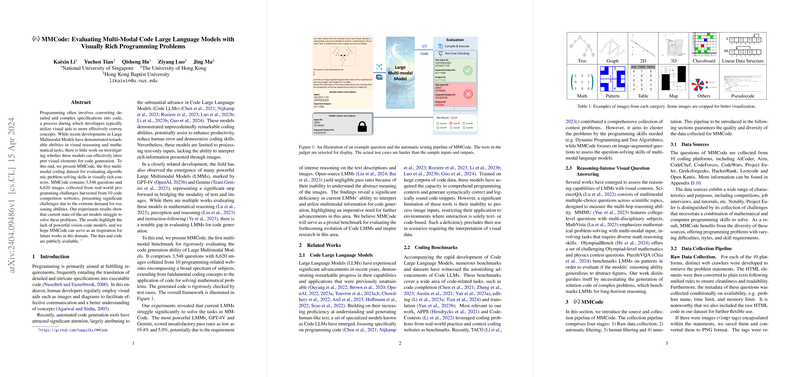Multi-Modal Code Generation: Challenges and Opportunities Explored through the MMCode Dataset
Introduction to MMCode
The proliferation of Code LLMs (Code LLMs) has significantly advanced automated code generation, demonstrating capabilities that augment human productivity and potentially democratize coding skills. Despite these advancements, a notable limitation of existing Code LLMs is their confinement to text-only inputs, neglecting the rich information conveyed through images—a common facet in programming challenges that utilize visual aids for concept illustration. Addressing this gap, the presented work introduces MMCode, a pioneering multi-modal benchmark tailored for evaluating code generation abilities in visually enriched contexts. MMCode comprises a collection of 3,548 questions paired with 6,620 images, sourced from an array of programming competition websites, meticulously chosen and processed through a rigorous data collection and filtering pipeline.
Examination of Related Works
Advances in Code LLMs
Code LLMs have evolved to grasp programming languages, generating code snippets with syntactical correctness and logical consistency. These models, trained on extensive code datasets, exhibit proficiency in code completion, editing, and translation tasks. However, their capabilities are restricted to text-based processing, overlooking the potential insights from visual data which often accompany programming specifications.
Code Generation Benchmarks
Existing benchmarks predominantly focus on text-based challenges, ranging from code completion to translation. Even though some benchmarks, like APPS and CodeContests, derive from real-world programming exercises, they remain confined to text, omitting the multimodal nature of many programming tasks.
Visual Reasoning in LLMs
In parallel, Large Multimodal Models (LMMs) have made significant strides, integrating text and image processing capabilities. These models open avenues for evaluating code generation in multimodal scenarios, albeit their efficacy in comprehending and integrating visual elements for code synthesis remains underexplored.
Insights from MMCode Data Analysis
Diverse and Challenging Question Set
MMCode distinguishes itself with its inclusion of numerous images per question, weaving a complex fabric of visual-textual data that challenges models' reasoning capabilities. The dataset showcases a significant variance in question length and image count, reflecting the multifaceted nature of programming challenges encountered in real-world scenarios.
Classification of Images
A nuanced categorization of images into twelve types elucidates the diversified challenges posed by MMCode. The dataset encompasses a broad spectrum of image categories, illustrating the complexity and variety of visual aids used in programming contexts.
Experimental Insights
Challenge Posed by MMCode
The results underscore MMCode's rigor, with current state-of-the-art models achieving subdued performance. Even the most adept models demonstrate limited success, highlighting the intricate challenge of melding visual comprehension with code generation.
Performance Disparity among Models
A stark performance disparity is observed between proprietary and open-source models, with the former exhibiting superior capabilities. This gap underscores the necessity for advancements in multimodal understanding within the open-source domain.
Multimodal Context Utilization
The inclusion of visual contexts has proven beneficial, albeit contingent on models' advanced comprehension abilities. Multi-modal inputs augmented models' understanding in certain cases, pointing towards the constructive role of visual data when effectively harnessed.
Implications and Future Directions
The findings from MMCode illuminate several pathways for future research. Firstly, the unmistakable challenge it poses invites enhancements in multimodal processing and reasoning within LLMs, aspiring towards models that adeptly navigate the intricate landscape of visual-programming tasks. Moreover, the evident performance gap between proprietary and open-source models calls for concerted efforts in advancing accessible LMMs capable of sophisticated multimodal integration.
Furthermore, the nuanced performance across different image categories suggests a tailored approach to model training, emphasizing image types where models currently falter. This specialization could pave the way for models that excel in contextually rich code generation tasks, thereby broadening the scope and applicability of automated programming solutions.
In conclusion, MMCode emerges not only as a benchmark for current LMM capabilities but also as a clarion call for innovation in multimodal code generation. It beckons a future where models transcend textual confines, embracing the full spectrum of programming semantics conveyed through both text and image, thus truly augmenting human intellect in the programming domain.
